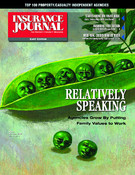Fortune 1000 companies’ auditing costs have increased by $1.4 billion collectively so far, and much of this increase is in response to the corporate governance act known as Sarbanes-Oxley, according to University of Nebraska at Omaha researchers.
The insurance industry has seen its audit fees escalate this year by more than 70 percent, while retailers have faced a 180 percent jump, the researchers found.
With figures as of April 27, a total of 633 Fortune 1000 firms have reportedly paid more than $3.6 billion for their 2004 audits, compared to $2.2 billion in 2003, according to accounting professors Susan Eldridge and Burch Kealey, who helped develop an automatic text-mining and data extraction technique that makes hundreds of hours of data-collection manageable.
The Sarbanes-Oxley Act of 2002, or SOX, passed in response to corporate financial scandals, requires U.S. businesses to report on their internal financial controls and to have those controls audited by outside auditors. Many businesses have complained the law requires them to spend large sums of money to ensure their accounting systems are in compliance.
In compliance with SOX, these companies had their first required internal control audits in 2004. These internal control audits are in addition to the historical financial statement audits for these companies.
Higher than estimated
The average audit fee increase of almost $2.2 million is significantly higher than the early SOX implementation cost estimates offered by the Securities and Exchange Commission. The SEC earlier suggested that companies would face an additional $91,000 in costs to meet the new internal controls requirements of SOX, and this estimate excluded internal control audit fees. These audit fee increases are only part of the true effect of SOX on costs of publicly listed companies, the UNO experts said. Other SOX costs include internal control documentation, implementation, and testing.
Kealey said that anyone looking at these figures should be cautious in interpreting these fee increases because not all are directly attributable to SOX compliance. For example, audit fees for Cabela’s, a Sidney, Nebraska-based outdoor outfitter, increased from around $177,000 in 2003 to more than $1.3 million in 2004. While Cabela’s does not directly disclose its SOX audit fees, it does indicate in its annual report that it paid auditors $935,000 for services associated with its initial public offering in 2004. Even after factoring that amount, Cabela’s saw audit fees increase by more than 140 percent, while its assets increased by one-third and net income increased by more than 20 percent.
SOX-related fees
“One limitation of our analysis is our inability to clearly identify what portion of the audit fee increase is due to the SOX internal control audit fees,” said Eldridge.
“We had hoped to find most companies providing disclosures of those SOX audit costs, but only slightly more than 10 percent of the companies actually reported the portion of their 2004 audit fee that was attributable to the new internal control audit requirement.”
For the 71 companies in the sample that did report actual internal-control (SOX) audit fees, these fees averaged $2.6 million. These firms also had average total audit fee increases of $2.6 million, indicating that for these firms, their entire audit fee increase was due to the new SOX internal control audits.
As part of their analysis, Eldridge and Kealey looked to see whether fee increases differed by industry.
“Patterns of increase seem to vary by industry in a predictable manner,” Kealey said. “You would expect insurance companies and banks to have strong internal controls because of regulatory financial audits, relatively centralized transactions and increased automation. These companies faced greater risk from fraud attempts than perhaps retail companies and thus likely had stronger internal controls and documentation of these controls than firms in other industry groups.”
Key industries had the following audit fee increases:
Of the 633 Fortune 1000 companies analyzed, 12 had audit fee increases of more than $10 million.
General Electric’s audit fees increased by $22.9 million, the largest dollar increase reported, representing a 41 percent increase.
Bristol Myers Squibb had the largest percentage increase in audit fees, an increase of more than 140 percent.
Eldridge and Kealey also reported Ford Motor Co., up 62 percent, from $25.3 million to $40.9 million; Boeing, up 90 percent, from $16.3 million to $30.9 million; and Honeywell International Inc., up 82 percent, from 14.2 million in 2003 to $25.9 million in 2004.
Only 11 of the 633 companies had audit fee decreases; one reported no change as compared to the amounts paid in 2003, the researchers said.
Was this article valuable?
Here are more articles you may enjoy.


 Trump’s Bond Insurer Tells Judge Shortfall Is ‘Inconceivable’
Trump’s Bond Insurer Tells Judge Shortfall Is ‘Inconceivable’  Grand Jury Indicts ‘Hole in Won’ Owner on Prize Insurance Fraud Charges
Grand Jury Indicts ‘Hole in Won’ Owner on Prize Insurance Fraud Charges  Former MLB Player, 3 Others Charged with Staging Auto Accident in Miami
Former MLB Player, 3 Others Charged with Staging Auto Accident in Miami  FBI Says Chinese Hackers Preparing to Attack US Infrastructure
FBI Says Chinese Hackers Preparing to Attack US Infrastructure 


